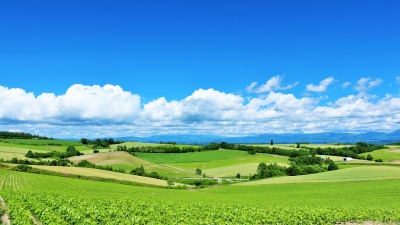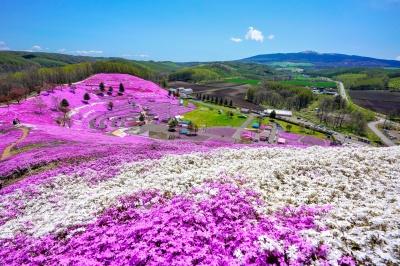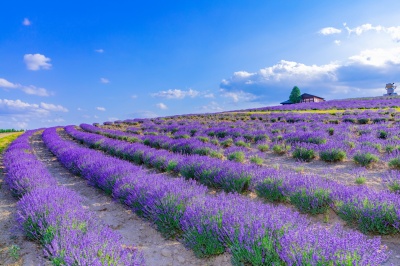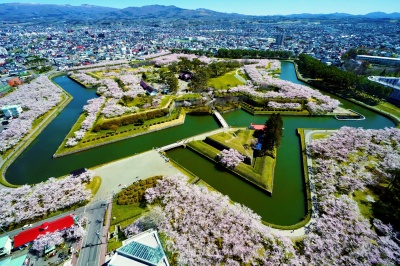Driving around Eastern Hokkaido – and enjoying the view

Eastern Hokkaido is home to arguably some of the most beautiful natural landscapes in the world, featuring scenic mountain passes, crystal-clear lakes, and seemingly endless straight roads. Due to its vast size, the area is best explored by car. Starting from Memanbetsu Airport, the natural entry point to the region, first you will want to drive east for about 1 hour towards the “Road That Leads to The Sky”. The name of this 28-kilometer straight road comes from the views it provides at certain vantage points when the road’s tip appears to be leading into the sky. From here, if you drive south for about 1 hour you will arrive at the Tsubetsu Pass. About 1 kilometer above sea level, from here you can enjoy a spectacular view of the Sea of Okhotsk and Lake Kussharo, the latter of which can appear to be completely engulfed in clouds from spring to fall. Continuing west for another hour, we arrive at Lake Saroma, the biggest lake in Hokkaido. For a great view of this majestic body of water, be sure to visit the Saroma Observation Deck. Finally, if you happen to visit the area in early fall (late August to late September), check out the stunning lakeside fields of red glasswort in Ubaranai at Lake Notoro, a phenomenon that occurs due to the region’s unique climate. As you can tell by now, this region truly has lots to explore – especially if you are traveling by car. So buckle up and enjoy the ride (while driving safe, of course)!
- * Please note that the text shown on this page includes machine translations.
Road That Leads to The Sky
Beginning as National Highway 244 and merging into National Highway 334, the “Road That Leads to The Sky” is a 28.1-kilometer-long road with absolutely no forks. Therefore, when looking down the road from vantage points that feature differences in elevation, the far-stretching road can appear to be leading up into the sky. To get to the road, follow National Highway 334 from Utoro to Shari and take a left at Minehama. You should be able to see the Unabetsu Ski Area on your left while driving up the hill. Once you reach the end of the road and turn right, you have arrived – the “Road That Leads to The Sky” suddenly stretches out in front of you. If you are in the area around the spring or autumn equinox, you have the unique chance to see a spectacular sunset, with the sun going down in perfect position directly over the road. Be sure to plan ahead though: due to the build-up of snow, the road is sometimes not useable during the spring equinox. Furthermore, if you are looking for that perfect shot of the road, make sure to avoid venturing into the nearby privately-owned fields.
Kaminokoike Pond
Formed by the groundwater swelling up from Lake Mashu, the Kaminokoike Pond’s has quite an interesting backstory with regards to its. Literally meaning “God’s Child Pond”, it got its name from stories that it is fed by underground waters from Lake Mashu, which is known as the “Lake of the Gods” by the Ainu. A small pond that has a perimeter of about 220 meters and is a mere 5 meters deep, it is well-known for its crystal-clear water. In the warmer months, the lush greenery of the forest contrasts incredibly well with the blue skies reflected in the shallows, which produces an eye-catching shade of cobalt blue. The water remains at a cool 8℃ throughout the entire year, which keeps the submerged trees from rotting and produces a beautifully mysterious scene.
Tsubetsu Pass
Of the four mountain passes that are around Lake Kusshoro, the highest is Tsubetsu Pass. Going up the pass by following the woodland path when the road splits, you will reach the Tsubetsu Pass Observatory after a short hike of 2.5 kilometers. Located at 947 meters above sea level, it marks the highest point from which you can enjoy the view of the lake. The spectacular panoramic view includes the Sea of Okhotsk, Mount Meakan, Mount Oakan, and the Daisetsuzan Volcanic Group in the distance. Furthermore, in the period from spring to fall, the lake is known for being engulfed in a sea of clouds, a scene that you have an especially good chance of catching in the early morning. Be aware that the observatory is closed from November to the end of May.
Chimikeppu Lake
“Chimikeppu” literally means the “place where water tears through the cliff” in the Ainu language. How does this relate to the lake of the same name? Well, it is believed that Chimikeppu Lake was actually formed about 10,000 years ago when a landslide stopped the flow of the river in the area. The nearby virgin forest is home to more than 40 different species of birds, including the black woodpecker which has been designated a “Natural Monument” in Japan. Its location outside of a major highway together with the fact that parts of the area are oftentimes closed in winter account for the overall lack of visitors to the lake – as well as its nickname, “Okhotsk’s Secret Lake”. However, if you want a truly unspoiled natural setting featuring lush greenery and insanely clear water, add Chimikeppu Lake to your itinerary!
Glasswort Community on Lake Notoro
Stretching out to the north of Abashiri City, Lake Notoro is technically a coastal lagoon and is connected through shallows and islets to the Sea of Okhotsk. In the early fall (from late August to late September), Ubaranai on the southern bank of the lake offers a truly spectacular view: the glasswort (sometimes also called Sea Asparagus or Samphire) turn an eye-catching red, producing a striking scene. This unique plant thrives in salt marshes, only grows between 15 to 30cm tall, and usually is a green color – until autumn, that is. To find a glasswort community of this size is extremely rare, making the resulting scene closer to something you would expect to see in a sci-fi movie than in Japan. While the whole area is a wetland making traversal extremely difficult, Ubaranai features wooden planks built specifically for viewing the spectacle.
Lake Saroma
Lake Saroma’s massive size spans Kitami City as well as the towns of Saroma and Yubetsu. Its perimeter of 90km and area of 152km2 make it not only the largest lake in Hokkaido but also the third largest in all of Japan, following Lake Biwa (Shiga Prefecture) and Kasumigaura (Ibaraki Prefecture). Situated centrally at the shore of the lake is Mount Horoiwa, from where you can enjoy a beautiful view of the lake at the Saroma Observation Deck. At 376 meters above sea level, it is the only place where the lake and its surroundings can be appreciated in their entirety: take special note of the unique geography of the nearby shoals! On a clear day, you can see as far as the Shiretoko Mountain Range. From the differing tones of blue on a clear summer’s day to the deep freeze that turns the lake an icy white in the winter months (not to mention the majestic sunrises!), the lake completely changes its appearance based on the season and time of day.
- Memanbetsu Airport
- Road to Heaven
- Kaminoko Pond
- Tsubetsu Pass
- Lake Chimikeppu
- Notoro-ko Coral Grass Colony
- Lake Saroma
*Google Maps is published here using a free quota with limited display counts. Please note that there may be periods when it cannot be viewed due to the circumstances. Your kind understanding is appreciated.
Ranking of popular articles
- Hokkaido Summer Travel Guide

- https://www.visit-hokkaido.jp/en/feature/travelguide_summer
- Hokkaido Spring Travel Guide

- https://www.visit-hokkaido.jp/en/feature/travelguide_spring
- When is the best time to see lavender? Recommended Lavender Spots in Hokkaido

- https://www.visit-hokkaido.jp/en/feature/lavender
- Here are the recommended cherry blossom viewing spots!

- https://www.visit-hokkaido.jp/en/feature/sakura
- Why the World Loves Ramen: The Story of Ramen Santouka

- https://www.visit-hokkaido.jp/en/feature/hatanakaoki





